The Louvre Museum in Paris is undoubtedly one of the most famous and most visited museums in the world and one of the must-see places in Paris. With an area of about 72,735 square meters, it houses a treasure of unique works of art and history and welcomes millions of tourists from all over the world every year. Great masterpieces, such as the Mona Lisa, the Venus de Milo painting, and the Sphinx statue are kept in this museum.
So if you are planning to visit the sights of Paris, do not forget to write the name of the Louvre Museum at the beginning of your list.
Where is the Louvre Museum?
The Louvre Museum of France is located in the heart of Paris, next to the Seine River and on the Place de la Concorde, rue Rivoli.
Access to the Louvre Museum
If you plan to visit the Louvre Museum on your trip to Paris, knowing the access routes to this place can make planning your trip easier; Of course, the location of the museum allows you to go there easily using public transportation.
The best way to access the French Louvre Museum is to use metro lines 1 and 7. If you use this metro line, you should get off at the “Royal Palace – Louvre Museum” station. This station connects you directly to the Carousel underground shopping center and then to the glass pyramid of the Louvre Museum.
You can also take metro line 14 and get off at Piramid station. This station is located near the glass pyramid of the Louvre Museum.
In addition to the subway, you can also use the bus to come to the Louvre Museum. Bus lines 21, 24, 27, 48, 68, 72, 81 and 95 go directly to the Louvre Museum.
If you don’t want to use the transportation system and you like to explore the streets of Paris, you can walk to the Louvre Museum from the side of the Seine or Place de la Concorde and visit the places near the museum.
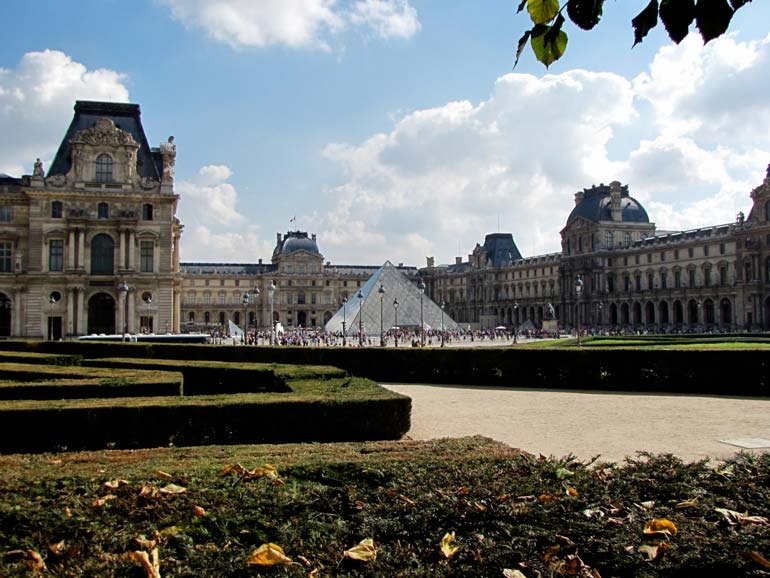
Image from: Britannica
The best time to visit the Louvre Museum
The Louvre Museum is one of the most visited museums in the world, especially in the tourist seasons (ie spring and summer). For this reason, there are crowds and long queues near the entrance doors of the museum.
This museum is closed on Tuesdays; For this reason, Wednesdays are considered the busiest working days of the museum, and the crowd in this place increases, and this crowding makes it difficult and impossible to see some works of art. So if you are looking for a quieter and more secluded experience, we suggest going to the Louvre on Mondays and Thursdays.
In general, the best time to visit the Louvre Museum in Paris is early in the morning, right after the doors open. At this time, the number of visitors has not yet reached its peak and you can safely visit the popular galleries and artworks.
Architecture of the Louvre Museum
The Louvre Museum in France is known both for its artistic masterpieces and for its variety of architectural styles, and this is one of the features of this museum. At first glance, the architecture of the museum may seem integrated; But throughout its history, many famous architects have renovated and expanded it.
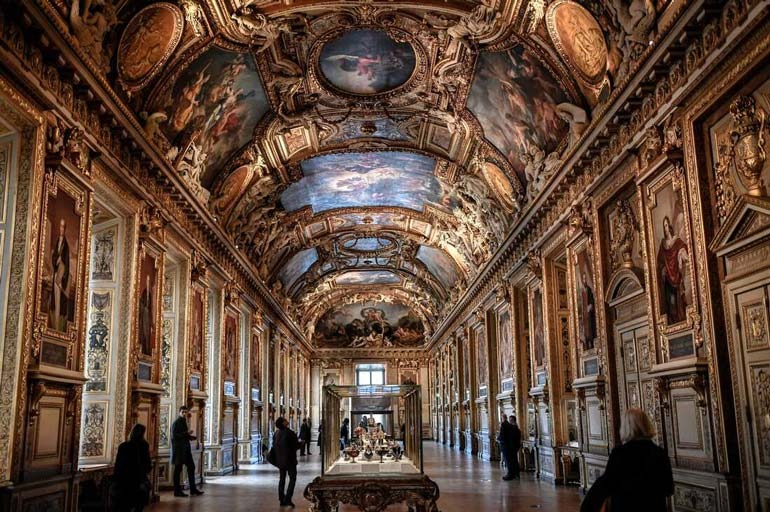
Image from: Npr
Initially, this building was built in the 12th century by the order of Philip. Then, during the 16th and 17th centuries, architects such as Louis Louv and Pierre Lescot added new parts to the castle and turned it into a royal palace. Finally, in 1793, the Louvre Museum in Paris was recognized as a public museum and opened to the public.
The Louvre Museum was renovated several times over time, the last important renovation was in 1989 with the construction of the glass pyramid at the entrance of I. M. Pi is done. This glass pyramid is known as a symbol of the Louvre Museum in France.
The exterior of the Louvre Museum in Paris is a combination of different architectural styles. The older parts of the building, built in the 12th century, are designed in the Romanesque style, and the newer parts, such as the entrance glass pyramid, are designed in the modern style.
The Louvre Museum has four different entrances:
- Verdi’s original glass pyramid of the museum in Napoleon’s courtyard
- Richelieu Corridor
- Carousel gallery entrance
- Entrance to the Porte des Lions
The museum building has 5 floors and 3 sides, which are connected by stairs, elevators and escalators.
Also, the museum includes 8 main sections, each of which is dedicated to historical periods or a specific type of art. Among these sections, we can mention the ancient Egyptian art section, the Greek and Roman art section, the European paintings section, the Islamic art section, and the sculpture section.
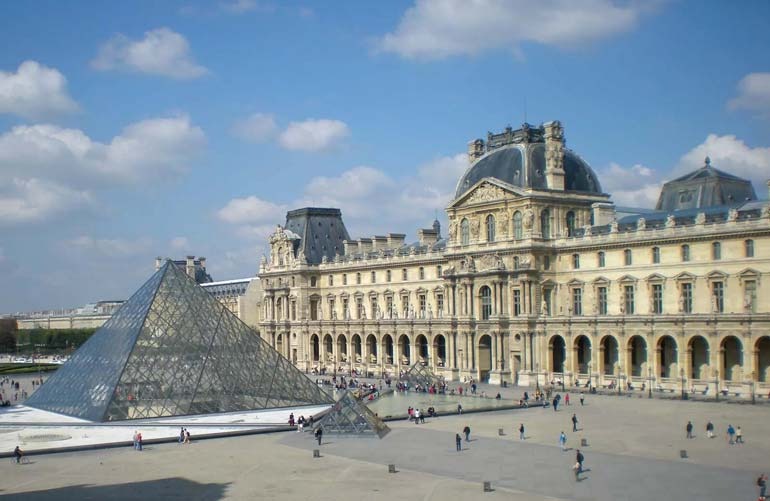
Image from: Britannica
Different parts of the Louvre Museum
By now, you have probably realized the size and nesting of the museum’s rooms. As we said above, to visit the works of art, you must visit one of the eight sections of the museum. To reach each of these sections, you have to go through one of these three lines.
Danon line
The Denon line is the longest line in the Louvre Museum and is named after the first director of the museum, Mr. Dominique Vivant Denon. If you want to see famous works, such as Leonardo da Vinci’s Mona Lisa and Nike, the winged goddess of victory, you must pass through this corridor.
Of course, don’t forget that this corridor quickly becomes crowded and full of visitors; So, if your goal is to see these works, come to this line in the first step.
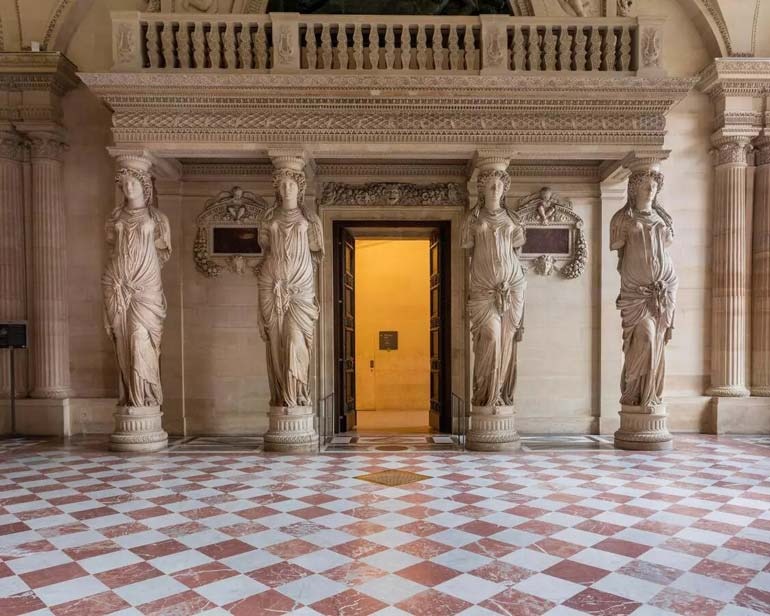
Image from:Louvre
Richelieu row
This order is named after the prime minister of Louis XIII, Cardinal Richelieu, and is dedicated to medieval and renaissance works of art; But in our opinion, what makes this order special and important for us and increases the value of seeing the works, is the presence of the ancient Iranian hall there.
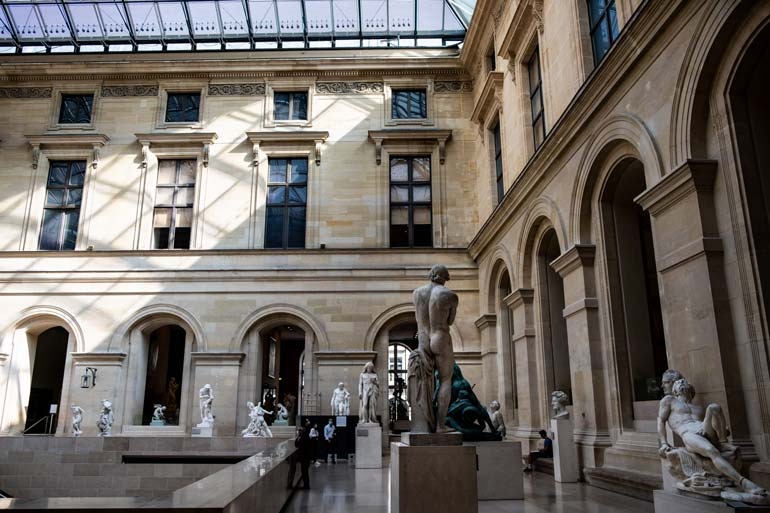
Image from: Frenchamericancultural
Sully line
This order is named after Maximilian Sully, Minister of Foreign Affairs of Henry IV. In this section, you can see works of art from different periods, including ancient Egypt, Greece and Rome, the Near East, and Islamic art.
The most important works of the Louvre Museum
The Louvre Museum of France houses more than 350,000 works of art and history, which date from ancient civilizations before the 6th century to the 19th century. These are the most famous works that you should not miss when visiting Paris and visiting the Louvre Museum:
Mona Lisa painting
The most famous painting in the world by Leonardo da Vinci, an Italian painter who is also known as the Jacund’s smile.
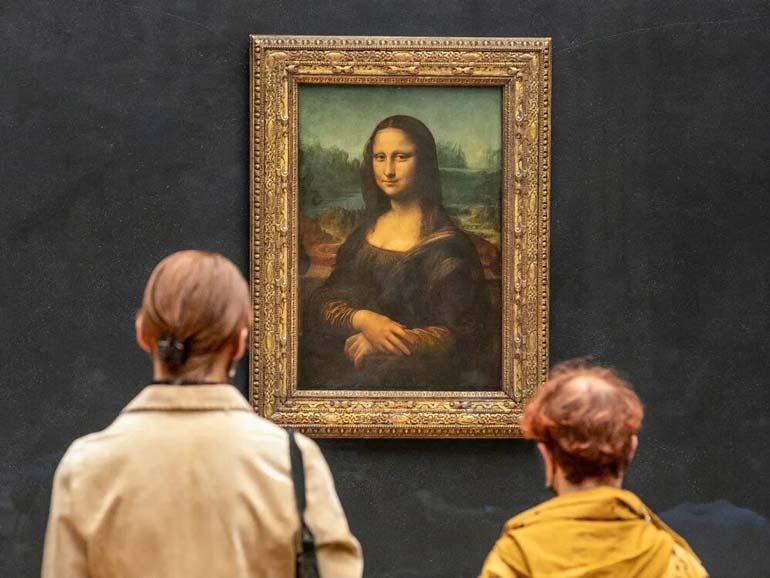
Image from: Thumbnailer
Coronation painting of Napoleon
An epic painting by French painter Jacques-Louis David depicting the coronation of Napoleon Bonaparte as Emperor of France.
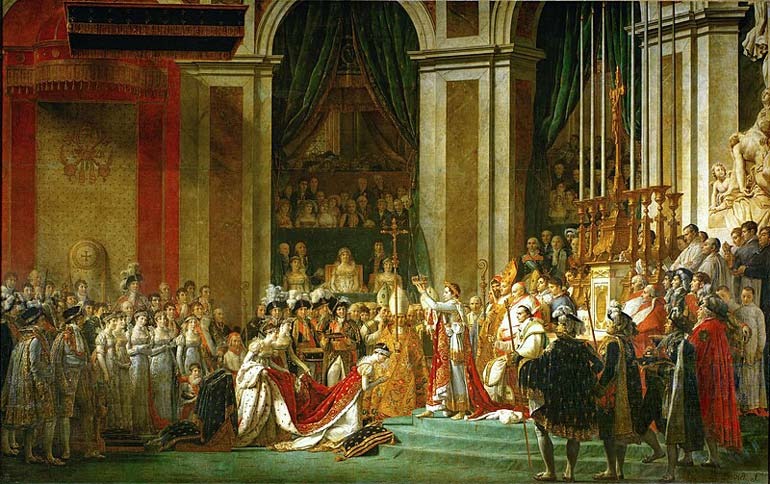
Image from: Wikimedia
Painting of a tailor
A delicate and detailed painting of a tailor at work, depicted by Dutch painter Johannes Vermeer, is the most important work of the Louvre Museum in Paris.
Drawing of a man and a glove
This oil painting was painted by the Italian painter Tissin in the Italian Renaissance style.
Painting of marriage in Cana
A work by Paolo Veronese, an Italian painter, which is one of the most famous religious paintings in the Louvre Museum in Paris.
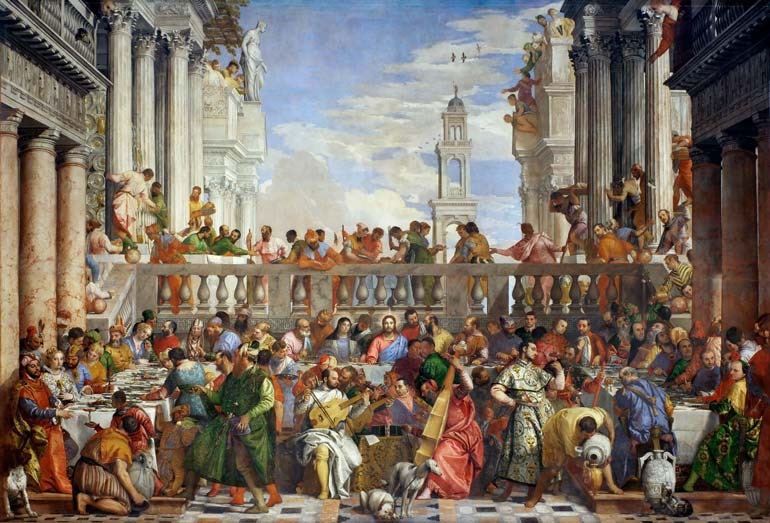
Image from: Wikimedia
Medusa boat painting
A sad painting of a sinking ship and the survivors wandering in the boat, by the French painter Théodore Géricault, drawn in the style of realism.
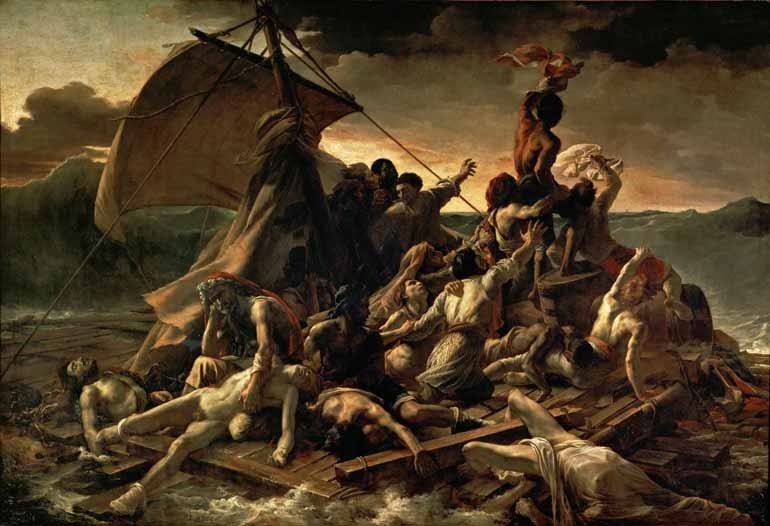
Image from: Wikimedia
A painting of an orphan girl in a cemetery
This oil painting by Eugène Delacroix, a French painter, has well depicted the sadness, fear, and terror of an orphaned girl.
Painting of the oath of the Horatians
This painting is an epic painting and one of the best works of the French Louvre Museum in the neoclassical style, which Jacques-Louis David, a French painter, depicts the story of the oath of three Roman brothers to defend their country.
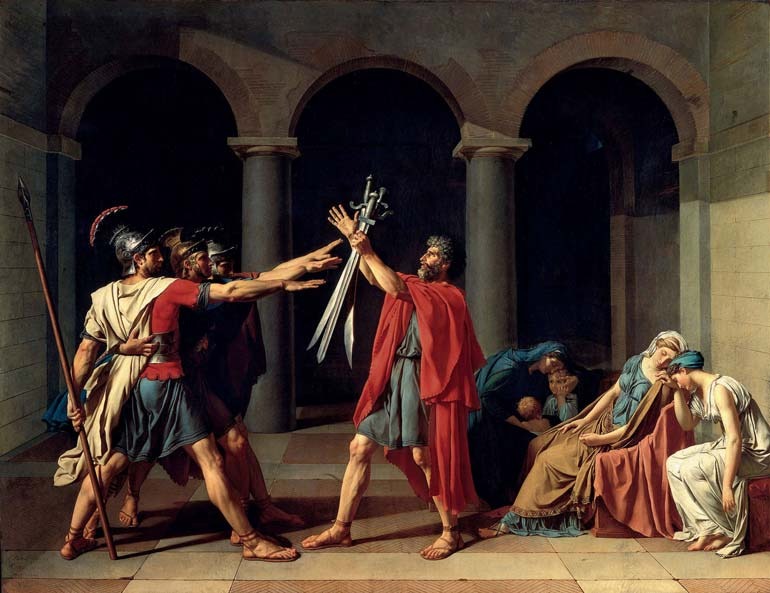
Image from: Wikimedia
Nice statue of Samothrace
The winged victory statue of Samothrace is a legacy of ancient Greece and one of the symbolic works of the museum. This statue was built in honor of Nike and victory in a sea battle.
Venus de Milo statue
The statue of Venus Milo, also known as Aphrodite, is a marble statue of the goddess of love and beauty in ancient Greece. Despite the broken arms, this statue still has its unique beauty and is one of the famous sculptures of the Louvre Museum.
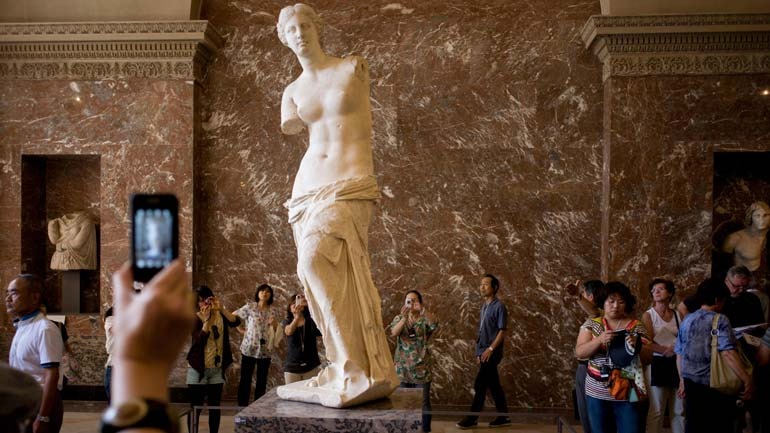
Image from: Thetimes
Marley horse statue
The Marley horse statue is a set of two marble sculptures of unruly and unbridled horses by Guillaume Cousteau, a French sculptor.
Statue of a seated scribe
This work, which is also known as the statue of the squatting scribe, is a limestone sculpture and a heritage of ancient Egyptian art that is kept in the Lorer Museum in Paris.
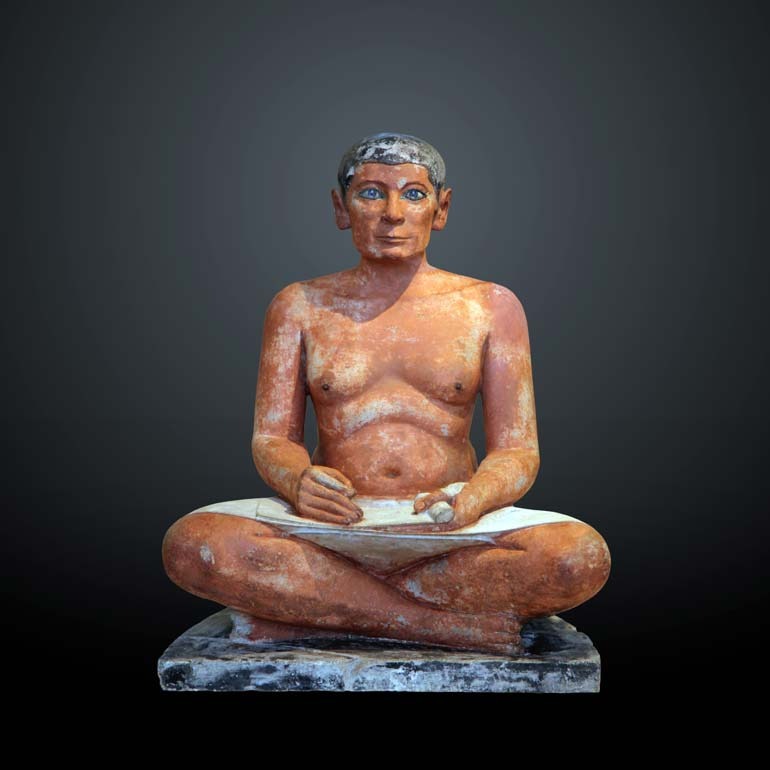
Image from: Wikimedia
Winged cow relief
The statue of the winged cow, also known as Lamasu, is known as a protective deity in ancient mythology, and for this reason, it was placed at the main entrances of the city for the purpose of protection.
The relief of the winged cow, which is located in the Louvre Museum in Paris, with a height of more than 4 meters, has been attributed to the ancient works of the Mesopotamian era.
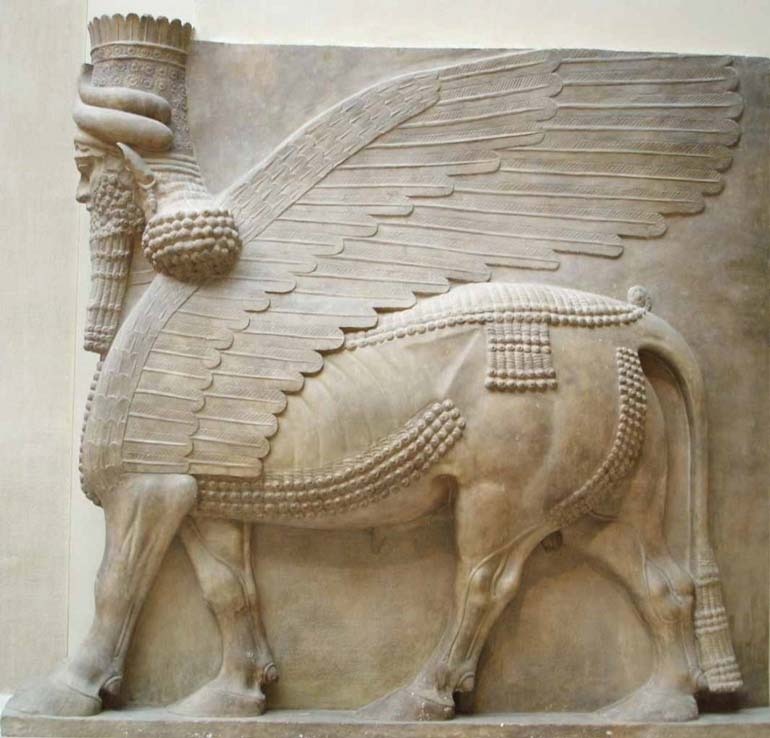
Image from: Thatmuse
Diamond of the Viceroy
This diamond with a size of 140.64 carats is one of the diamonds of the former royal diamond collection, which is kept in the decorative arts section of the Louvre Museum in France.
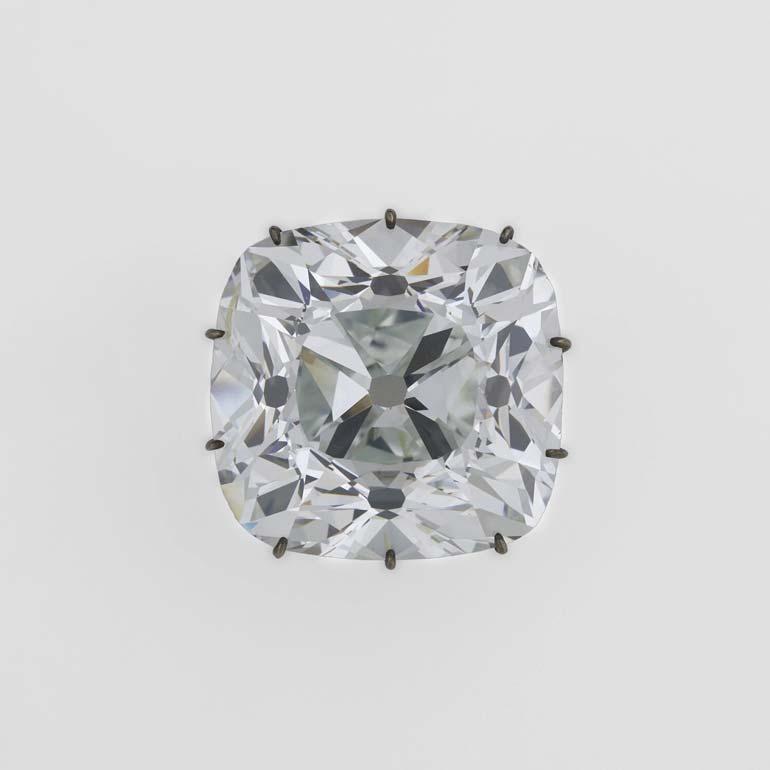
Diamond of the Viceroy
Iran section in the Louvre Museum
The Iranian section of the Louvre Museum in Paris has a valuable treasure of Iranian history and culture in its heart and is known as one of the most visited sections of the Louvre Museum.
The Iran section is located in the Richelieu Wing on the ground floor (floor 0) and rooms 232 to 316. To visit this section, you can go up the stairs and go to room 231, then enter room 305 on the left and continue until you reach Iran Halls.
Upon reaching this section, you will see one of the most complete collections of Iranian antiquities outside of Iran. This section of the Louvre Museum houses more than 5,000 works from different eras of Iran’s history. Among these works, we can mention statues, capitals, inscriptions, pottery, ornaments and coins.
We refer to the following list of the famous and most prominent Iranian ancient works in the Louvre Museum that you should not miss:
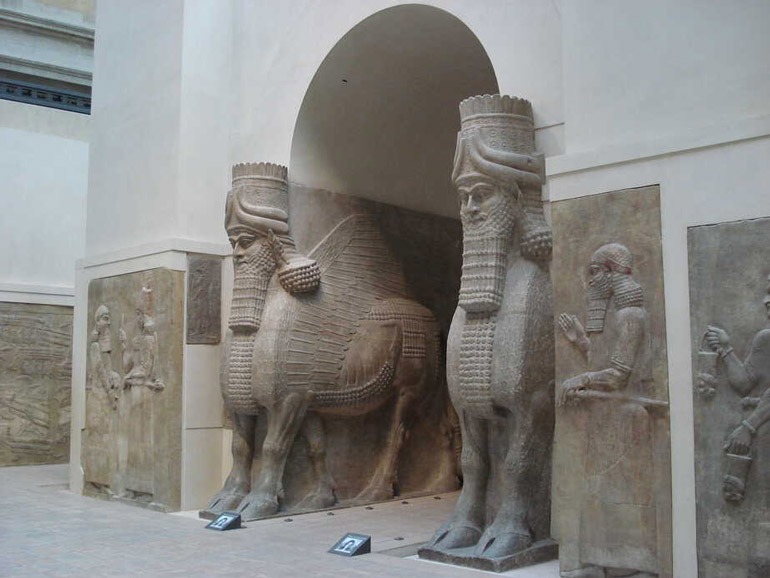
Image from: Titian
- The capitals of Persepolis: these capitals, which were transferred from the Apadana Palace in Persepolis to the Louvre Museum, are a symbol of the greatness and glory of the Achaemenid Empire; Of course, these capitals are not the only remaining works from Persepolis, and you can see a collection of works of this magnificent Iranian building in the Louvre, France.
- Hammurabi’s Tablet: Another wonder of the Louvre Museum is the Hammurabi Tablet, one of the works of Hall of Iran. This stone tablet, which dates back to the Babylonian era, shows in cuneiform a set of laws enacted by Hammurabi, the king of Babylon.
- Archers petroglyph: This petroglyph is a terracotta brick inscription that depicts and displays the art of ancient Iran, namely the luxurious and famous residential decorations of the Apadana Palace built by Darius I in Susa.
- Petroglyphs of Elamite women and maidservants
Bronze bridle of Lorestan - statue of Napirasu
- Azure cuckoo statue
- The painting of the sun nuns’ prayer ceremony
- 58 house game board

Image from: Thetimes
Amenities of the Louvre Museum
You need almost a full day to see only a part of the museum; But don’t worry, the Louvre Museum offers many amenities to make the visit experience more comfortable and enjoyable.
- The ability to buy Louvre Museum entrance tickets online is one of the best museum services for visitors to save you from standing in long queues and get you to the art and historical works faster.
- If you think that the size of the museum and the twisting of the corridors will cause you to lose your way, we must say that the Louvre Paris software, museum map, English guide in Android and iOS versions are among the services that will help you to solve this problem.
- The Louvre Museum has thought of ordinary people as well, and with the installation of a special path for wheelchairs, elevators and lifts, etc. It has made it possible for these people to visit different departments.
- Other amenities include a coffee shop, restaurant, restroom, and parking lot near the museum.
Places of interest near the Louvre Museum
The Louvre Museum is located in the center of Paris and is close to many sightseeing and tourist attractions. We suggest visiting these places of interest after visiting Sri Museum to make your trip more memorable.
Tuileries Garden in Paris
After visiting the masterpieces at the Louvre Museum, just take a few steps west to find yourself in the Tuileries Gardens, one of the most beautiful gardens in Paris. This garden was built in the 16th century by order of Catherine de Medicis, the wife of King Henry II of France, which has gone through many events throughout history.
At first, this garden was used as a recreation and resting place for the royal family and courtiers. In 1677, following the request of French writer Charles Perrault, the doors of the Tuileries Garden were opened to the public. Since then, the Tuileries became a popular place for recreation and leisure for the people of Paris.
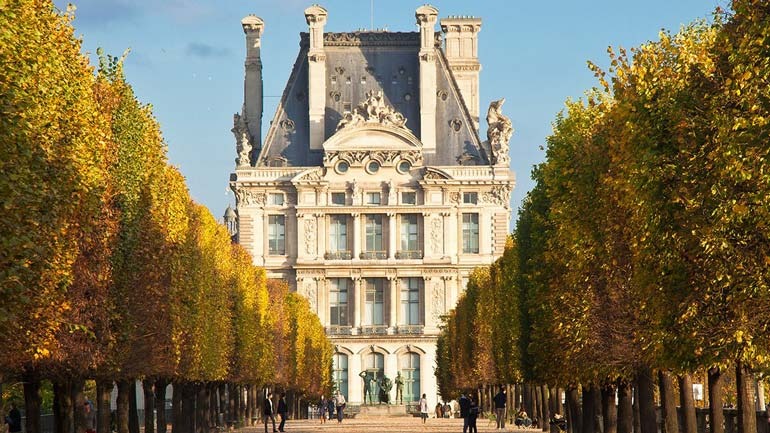
Tuileries Garden in Paris
In 1791, with the outbreak of the French Revolution, the revolutionary people seized this garden and declared it as a national garden. Unfortunately, in 1870, the Tuileries Palace, which was adjacent to the garden, burned down in a terrible fire. This event was a heavy blow to the Tuileries Garden and its beauty and glory were lost to a large extent.
In the following years, the rest of the Tuileries Palace was demolished and rebuilt. Today, the Tuileries Garden, with an area of about 25 hectares, has become a relaxing place to relax and enjoy nature with spectacular sculptures, magnificent fountains and tall trees.
As we said at the beginning, you don’t need to travel a long distance to reach this garden. It is less than 3 minutes by car from the Louvre Museum to the Tuileries and about 15 minutes on foot.
Concorde Square, Paris
Concorde Square, less than 2 kilometers from the Louvre Museum, is another tourist attraction that should not be missed. This magnificent square is one of the largest and most famous squares in Paris, with an area of about 8.5 hectares, located at the eastern end of the Champs Elysees.
The history of Concord Square dates back to the 18th century. At that time, this square was known as the Place Louis XV and there was a statue of this king in the center; But during the French Revolution, the statue of Louis XV was toppled and the square was renamed Place de la Concorde, meaning “Square of Solidarity”.
The special architecture of this building, which is a symbol of the 8 important cities of France, includes the ancient Egyptian obelisk statue in the center of the square, water features, many historical and scenic buildings such as Bourbon Palace and Crillon Hotel, photography, etc.
You can also visit the Musee d’Orsay, Cafe Angelina and the shops of Saint-Oreau Street after exploring the Place de la Concorde.
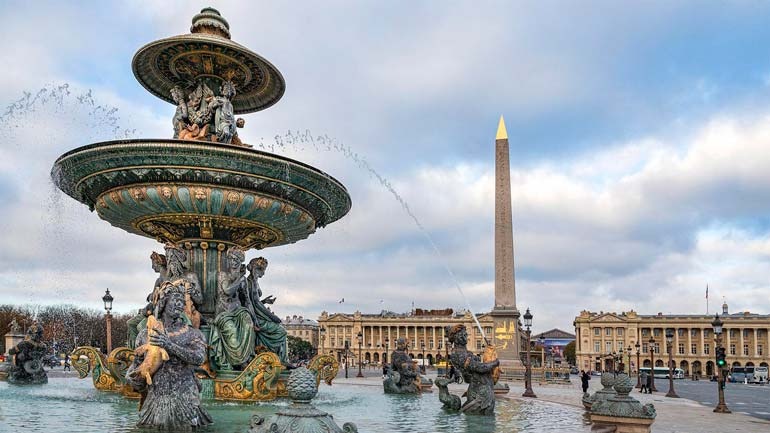
Image from: Meinfrankreich
Orsay Museum in Paris
If you are still not tired of seeing works of art, you can reach the Musée d’Orsay in about 10 minutes after visiting the Louvre Museum in Paris. This museum, which is located in a magnificent building on the banks of the Seine, was opened in 1986 and houses French works of art from 1848 to 1914.
If you visit this museum, you can see the works of famous artists such as Monet, Renoir, Van Gogh and Picasso.
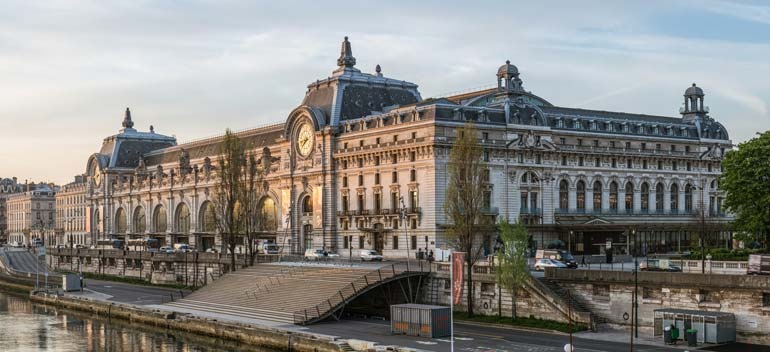
The Pont Neuf bridge in Paris
The Pont Neuf bridge in Paris
At the end of the daily tour in Paris and places near the Louvre Museum, we suggest you reach the Pont Neuf bridge, approximately 800 meters away from the museum. This bridge is the first stone bridge in Paris, which was built in 1607 by the order of King Henry IV, and today it is known as one of the symbols of the city of Paris.
Walking on this bridge, watching the sculptures, spectacular views of the Seine River and photographing its beauty will be an unforgettable experience for you.
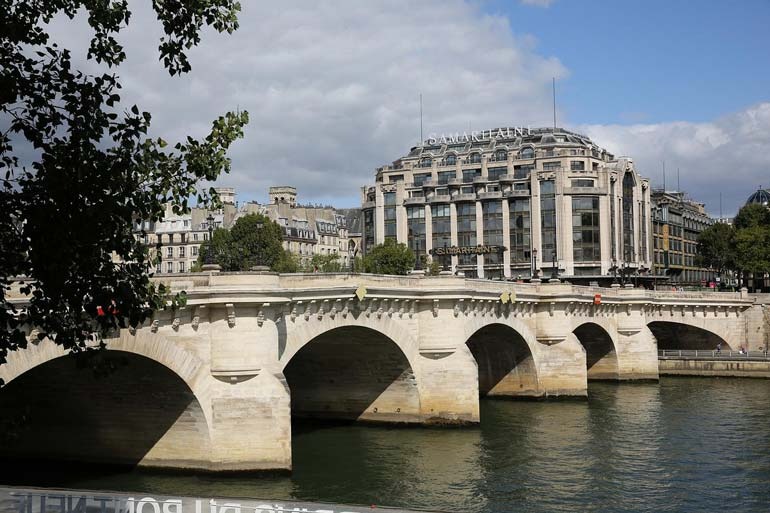
Image from: Tripadvisor
History of the Louvre Museum
What you see now from the Louvre Museum in France is the result of a long story in the heart of history. This building was originally built in 1190 by order of Philip II as a fortress to protect the city of Paris. In the 14th century, during the reign of King Charbez V, this castle became a royal residence, which includes a part of today’s Louvre Palace.
During the 16th and 17th centuries, various French kings, including Louis XIII and Louis XIV, completed other parts of the Louvre.
In 1682, Louis XIV decided to move to the Palace of Versailles and turned the Louvre into a place to display works of art. The first art collections transferred to the Louvre included paintings and sculptures belonging to the royal family.
However, by transferring the works related to the royal family to the Louvre Museum, ordinary people could visit them; But in 1793, at the same time as the Great French Revolution, the Louvre became a public museum with only 537 paintings.
During the 19th century, the Louvre was greatly expanded and several new sections were added to make it one of the largest museums in the world today.
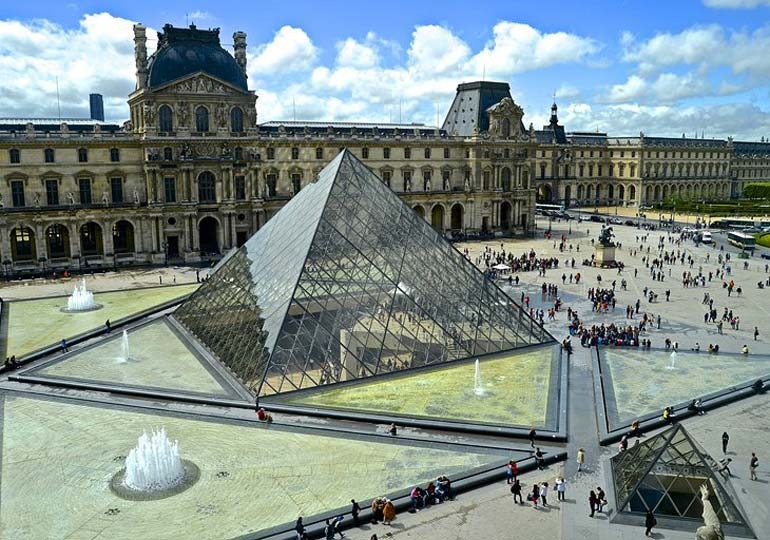
Image from: Planetware
Changing the name of the museum in 1803 is another important event that the Louvre has gone through during this period. At this time, the name of the museum was changed to the Napoleon Museum in honor of the French emperor; Of course, it goes without saying that during this period, Napoleon increased the interior space of the museum in order to display the honors and works of art he had won in his battles.
The theft of Leonardo da Vinci’s Mona Lisa painting in 1911 was considered one of the unfortunate events of the museum, fortunately, two years later, this painting was found and returned to the Louvre Museum in Paris.
Among other events, the museum was closed during World War II. During the war, the Nazis stole or destroyed many works of art; But with the intelligence of the museum director at the time, many treasures and important works were removed from the museum and kept in another safe place.
The reason for naming the Louvre Museum
There are various narratives about the name of this museum, among the most famous of which we can mention the following.
- Some consider the origin of the word Louvre to be the Latin word Lupara, which means the land of wolves. The reason for this name is the presence of many wolves that lived in this area in the past.
- The name Louvre is derived from the French word Louvre (Louvre) which means fortress or castle. This castle was built by the order of Philip Augustus to protect the city, which later became the Louvre Palace.
- A group believes that the name of this tower is derived from its function as a place for observation and guarding.
Recommendations for visiting the Louvre Museum
Now that you are familiar with the parts of the Louvre Museum and the variety of its works, we suggest that you write a plan for yourself before coming to the museum and determine your travel routes. To some extent, this will prevent wasting time and getting stuck in the crowd of tourists.
It is better to pay attention to these things:
- Do not come to the Louvre Museum in France without proper walking shoes. Since you have to spend long hours (at least 4 hours) on the floors of the museum to see works of art, using an inappropriate shoe will make you tired sooner.
- Carrying a map of the museum will help you experience a better visit and have the opportunity to see your favorite works.
- You can buy the Louvre Museum ticket in two ways, in person or online. If you don’t want to stand in a long ticket queue, it’s better to try the online purchase option.
- Of course, let’s also say that the cost of online tickets is more expensive than buying them in person.
- Visiting the museum is free for people under the age of 18 (with proof of identification), disabled people and their companions, and people between the ages of 18 and 25 living in the European Economic Area.
- If you book a group ticket to visit the Louvre Museum, facilities such as a special room for rest, personal lockers will be provided to you.
- In addition to Tuesdays, the Louvre Museum is also closed on January 1, May 1, and December 25; But in general, you can visit the museum on Mondays, Wednesdays, Thursdays, Saturdays and Sundays from 9:00 am to 6:00 pm and on Fridays from 9:00 am to 9:45 pm.
Now that you know all the important tips for visiting the museum, it’s time to pack your bags and travel in the heart of history, art and culture. If you visited the Louvre Museum during your trip to France, we would be happy to share your opinion with us.

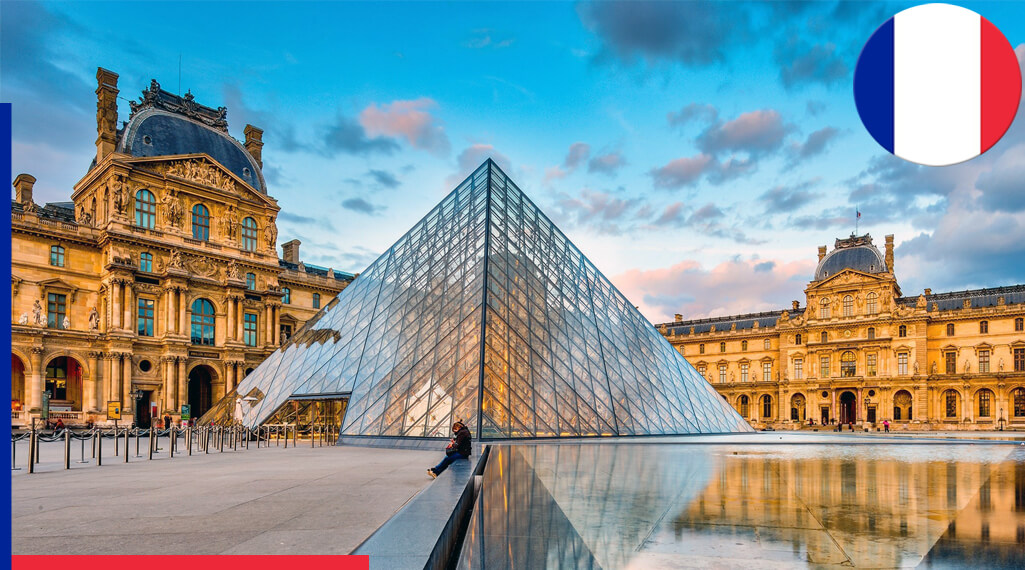
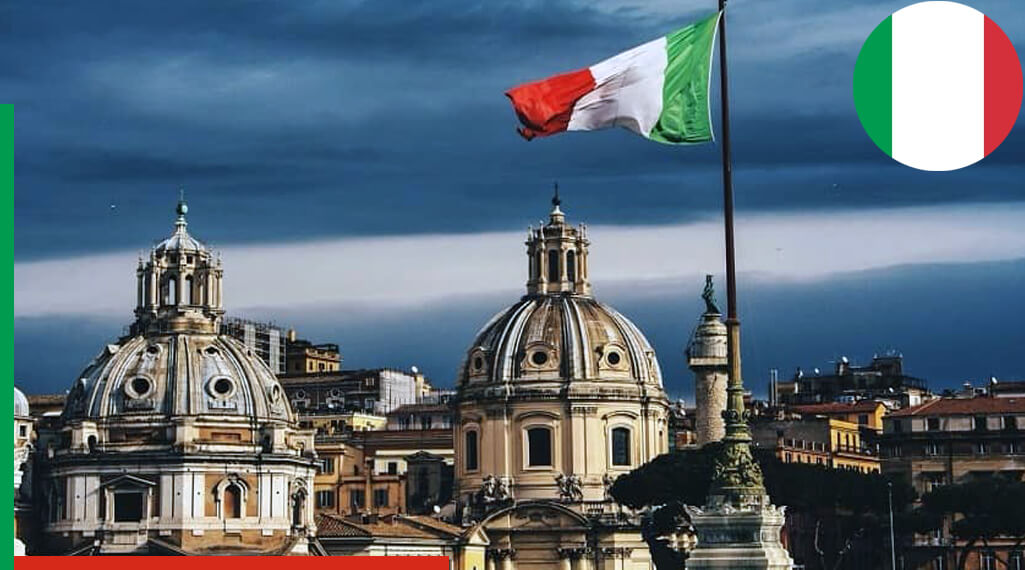





Recent Comments